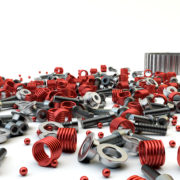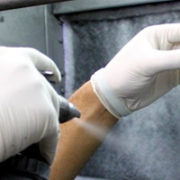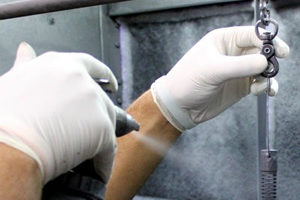Quality Department Discovers Reason for Aerospace Engine Threading Failure
More goes on than measuring in PTI’s quality department. Assuring quality results is a dynamic process that isn’t limited to meeting the customer’s definition of quality. It’s going above and beyond the scope of quality department work to satisfy every customer requirement.
Sometimes this involves satisfying a requirement for a problem that a customer doesn’t know exists. For Dawn Stokes, Quality Assurance Manager, making sure everyone is following the rules is her primary focus. But when every rule is adhered to and something comes back flagged as a problem, it’s time to dig deeper.
PTI experienced a problem solving challenge with a major aerospace company’s parts that came in for dry film lubrication. “That’s how we discovered it. They thought it was a dry film issue because after our process, it wasn’t working,” Stokes said.
Dry Film Lubrication (DFL), also known as solid film lubrication, is the ideal solution for lubricating your parts when liquid-based lubricants fail to function properly. The dry film protective coating is more reliable for reducing surface friction between part surfaces.
The DFL department treated the engine parts with a protective coating and sent them on to quality. They passed inspection and were returned to the customer who promptly discovered a threading issue. During assembly, the parts, involving several engine orders, weren’t torqueing together correctly. The problem was believed to be in the dry film application and presented again to quality for inspection.
The quality department got help troubleshooting the problem parts from their “threading expert” who has background knowledge with threaded parts. Why weren’t the parts working properly under the specific threading dimensions they needed to adhere to? The problem wasn’t the dry film process, the expert determined, but the threading dimensions as defined in the blueprint.
“Looking closer at the prints, it just jumped out at him with all his thread knowledge,” Stokes said. “So he did the math to adjust the pitch in the threading,” and many conference calls with the customer later, the problem was resolved.
After careful review of the problem internally, the customer found that there was more than one engine group that had this same threading issue, and they ended up changing the requirements on their prints. They were able to apply this same engineering solution to another engine within the same part family.
Fixing problems in the quality department involves understanding the customer’s real needs and applying problem-solving skills that deliver true resolution and not just temporary fixes. Whatever special processes need you have, we have the expert to give you quality that goes beyond your requirements.


 In a previous post we spoke about streamlining your special processes to improve your bottom line. Now we’ll take a look at how one part would move through our multi-process shop. Four processes can equal one when a part has four sequential special processes done in one shop on one purchase order. To illustrate this, let’s look at a section of the value stream map for a Locking Nut that mates up to an LPT Shaft, which ultimately ends up in a jet engine.
In a previous post we spoke about streamlining your special processes to improve your bottom line. Now we’ll take a look at how one part would move through our multi-process shop. Four processes can equal one when a part has four sequential special processes done in one shop on one purchase order. To illustrate this, let’s look at a section of the value stream map for a Locking Nut that mates up to an LPT Shaft, which ultimately ends up in a jet engine.
